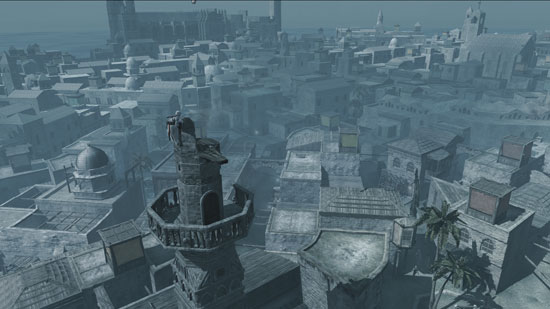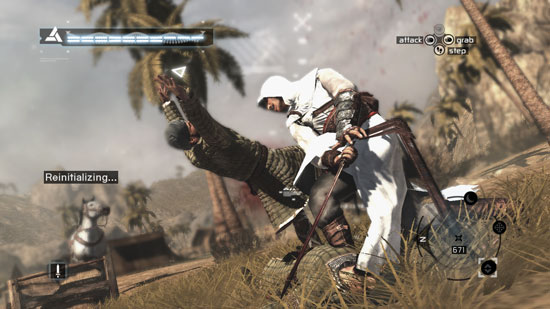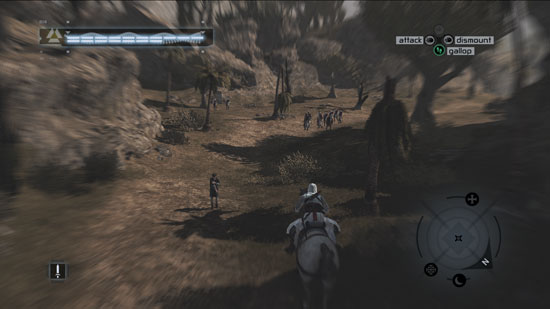Graphics and Design Decisions
AC has some very impressive graphics, but there are also some design decisions that have us scratching our heads (we'll get to those in a moment). The engine supports the latest buzzword features: high dynamic range lighting, motion blur, environmental bump mapping, depth of field effects.... If you want a game that will make good use of your DirectX 10 graphics card, AC certainly qualifies. That's not to say the graphics are better than Crysis, but they do a good job of portraying a 12th-century environment. (Worth mention is that DX9 cards are also supported, and in testing on DX10 hardware we didn't immediately notice any major differences. If you're still holding on to Windows XP, you can enjoy Assassin's Creed without any serious loss of quality.)
 |
The maps that you visit during the course of the game are the true star of the show, giving the player huge areas to explore with nary a loading screen in sight. There are loading screens in between the main areas, but once you enter a city -- i.e. Jerusalem -- you are free to explore the whole town with no further delays. That's not to say that you can explore all of each map from the start; you will need to unlock additional "memories" before you can enter the three parts of each main city (Damascus, Jerusalem, and Acre). However, late in the game it was nice to be able to navigate an entire city. We just wish some later missions would have involved more than one city area.
 |
If there's one area of AC that truly impresses us, it is without doubt the character animations. Watching Altaïr move around through the city -- disregarding the slight swing in his hips -- looks natural, but that's nothing special. It's when you start running, jumping, dodging through crowds, and climbing various structures that the work of the artists begins to shine. If you ever watched some of the online videos of Parkour or Free Running, you will have some idea of what it's like to move through the cities in AC. We wouldn't go so far as to call the animation "perfect", but for the amount of environmental interaction that takes place it comes darn close. The fluid animation extends to the fight sequences, where Altaïr has a huge variety of finishing moves. Which move he uses is essentially random, but they all look great.
One other aspect of the game that certainly warrants discussion is the control system. Most PC gamers have now experienced ports that suffer from a severe case of "consolitis" -- the feeling that a game was ported from a platform where a gamepad was standard, and no one ever took the time to properly modify things so that mouse and keyboard users will feel at home. While there are a few areas where colsolitis shows up -- without using the Alt+F4 shortcut, it can take well over a minute to exit the game as you navigate through the various menus and areas -- mouse and keyboard support is very well done. In fact, mouse and keyboard support is so well done I almost wonder how people could play this game using a gamepad. I tried it with my Xbox 360 controller, and it only took a few minutes before I was back to using the mouse and keyboard. Others might feel differently, but this is one console port where a gamepad is definitely not required.
 |
Now let's get to our complaints with the graphics and game design. One complaint is that areas tend to look very similar. Building and architectural styles might vary a bit between Damascus, Jerusalem, and Acre -- not to mention the Kingdom map -- but the Middle East setting does necessitate a certain look and feel with little to differentiate one town from another. Initial impressions are very favorable, but the longer you play the game the more repetitive the environments begin to feel.
Perhaps a bigger concern is Ubisoft's choice of presentation. We've complained in the past about games that lack proper widescreen support -- for example, the Battlefield series does not offer proper aspect ratio control, with early titles stretching the image to fill your screen and the last two versions cropping the top and bottom edges. The approach in AC is different, but in some ways it's almost worse. Regardless of what resolution you choose to run at, AC will render as a 16:9 aspect ratio. If you have a 16:10 computer monitor, you will get black bars on the top and bottom. If you have a 4:3 or 5:4 display, you'll get even larger black bars on the top and bottom! Only 16:9 resolutions (i.e. 1280x720 or 1920x1080) avoid the black bars, but unless you're playing on an HDTV you'll end up with a stretched image or black bars regardless. We understand that there's a certain amount of artistic presentation in a game, but it still shocks us that the designers felt it was better to force users to see a widescreen image than to let them decide for themselves how the game looks best.
Then we come to the major can of worms: DirectX 10.1. What exactly does DirectX 10.1 allow you to do that can't be done in DirectX 10? In terms of actual graphic effects, it adds nothing. What DirectX 10.1 does allow is the ability to do certain effects in a single pass rather than two separate passes. So if one graphics chip requires five passes to render a scene and a competing chip can render the same scene in four passes, all other things being equal you would expect the four-pass chip to be ~25% faster. As far as we can tell, Ubisoft uses (used) DirectX 10.1 in order to render anti-aliasing without incurring a substantial performance hit. Depending on your computer system, if you have one of ATI's HD 3000 series cards, you may be able to enable anti-aliasing with little to no performance loss. That's the only difference we noticed during testing, though the 1.02 patch removes DX10.1 support. We'll look at this in a moment, but we need to talk about another complaint with the game design first.
"Free" anti-aliasing sounds great -- if it works. The problem is, at present the only way to get anti-aliasing is via the in-game menus; trying to force anti-aliasing through the ATI or NVIDIA drivers does not work right now. This wouldn't be a concern at all, except Ubisoft decided to limit anti-aliasing support to certain resolutions. Specifically, the maximum resolution that allows users to enable anti-aliasing is 1680x1050. That was a very shortsighted decision, considering newer and faster graphics cards and other hardware are continuously appearing. While top-end hardware of today might struggle at 2560x1600 with 4xAA, there's little doubt that future hardware will be able to run such settings on AC without difficulty.
There are basically three areas that we would like to see addressed with a future patch. First, we would like to see the aspect ratio support "fixed". Users should be given the option to choose whether they would like an letterbox format with black bars on the top and bottom or an image that fills their entire screen. Second, we would like to see anti-aliasing allowed across all resolutions; we understand that not all computer hardware is going to be able to handle high resolutions with 4xAA, but at least give us the chance to try it out. Computer gamers are generally savvy when it comes to tweaking graphics settings; if it's too slow, we are fully capable of disabling anti-aliasing or lowering the resolution. Finally, Ubisoft really needs to bring back DirectX 10.1 support. It's one thing to not add a feature that a lot of gamers can't use; it's a completely different story to remove a feature that was already present. We can't help but feel there were some conversations between Ubisoft and NVIDIA personnel that resulted in the removal of DX10.1 support.
And with that said, let's take a look at actual graphics performance on a couple of systems.






















32 Comments
View All Comments
geogaddi - Tuesday, June 10, 2008 - link
...now, what did i do with that babelfish...
ssgoten00 - Monday, June 2, 2008 - link
AC was only an average game overall. Graphics presentation was it's strong suit but gameplay was lacking and the game seemed to drag on as the player progresses through the game. Undoubtedly the repetitiveness was the worst part of AC. Not simply the fact that is seemed like some tasks were a redue of previously accomplished tasks but the shear fact that tasks were repeated verbatim with same characters and voices, only changing dialogue to create variation. Some characters players will have to kill multiple times under the guise of actually killing different characters in the game. AC was also disappointing in the fact that it mislead gamers in presenting its self a a somewhat stealth game. Nothing could be further from the truth. In AC players will often be forced into full on combat with multiple opponents to progress in the storyline. In vary select situations players have the choice of using stealth as a viable option. Ironically the last 5 or 10 minutes at the very end of the game are the most compelling. After the credits roll players are left in the main room to explore and decrypt code and hidden messages. It's unfortunate AC's developers couldn't have spent more time on puzzles that actually pertained to gameplay. Out of a possible 10 I give Assassin's Creed a 6.0 barely coming in at par, bordering on subpar.Donkey2008 - Monday, June 2, 2008 - link
It does have a Thief feel but after playing it on Xbox, I found it to be more Thief meets BloodRayne meets Splinter Cell with some of the best graphics I have seen in a while. It is sorta repetitive,but the violence cut away any boredom I had. I enjoyed it a lot.But I guess they could have done what other Rockin high-profile companies do and make an even more repetitive game exactly like its previous versions, but with a much worse soundtrack. Throw in some terribly low-res character models and reuse the same, bottom-of-the-barrel, cartoon-looking cutscenes and they would have a perfect 10 as well.
poohbear - Monday, June 2, 2008 - link
this is the kind of game reviews i'd like to see, wherein hardware is tested w/ a game to show performance. I mean, you guys ARE a hardware site and there are'nt many sites that do game reviews w/ hardware testing shortly after. I dont think u should do game reviews without hardware testing cause there are a ton of game review sites, but your niche shines when you do these hardware and DX analysis. cheers and thanks for a very informative article.DesertCat - Monday, June 2, 2008 - link
The article talks about wanting to check the performance of Assassin's Creed on a Phenom processor (and its 4 cores). I can speak to that to some degree.I have a Phenom 9600 (2.3 MHz) on an AM2 board (Asus M2N-SLI Deluxe) with an EVGA 8800GT OC (650 MHz). I play at 1280x1024 so I play in a letterbox mode. This processor is enough to run the game at acceptable frame rates but I would tend to think that a fast dual core would do just as well (like was found with the Intel processors in the article).
With the performance hurting TLB patch enabled, I noticed one area where frame rates truly took a nosedive: when doing the "look" pan from the top of one of those towers. I didn't have an fps counter on at the time, but I'm guessing it was in the 12-16 fps range based on the chunkiness I experienced. I got similar slow framerates when diving from those spots into the hay (especially the really high towers).
With the TLB patch disabled on my Phenom, those two low fps spots were much better. I'm guessing that those areas were in the low 20's of fps. The rest of the game was smooth as silk and probably above 40 fps. I do not, however, see high utilization on any particular core when I've checked.
If I was to point to areas that really stress a system in AC, I would say that the tower pan shots are the most common. (*minor spoiler ahead*) King Richard's speech from horseback about 3/4 the way through the game is also very intensive.
aguilpa1 - Monday, June 2, 2008 - link
I know I've had it for a long time?emboss - Monday, June 2, 2008 - link
The word you *are* looking for is possibly letterboxing?PrinceGaz - Monday, June 2, 2008 - link
I was going to mention that as well. Anamorphic means the pixels making up the image are stretched either horizontally (as with wide-screen DVDs) or vertically when displayed. If the game were anamorphic, it would be like it running on a monitor at 1920x1080 but being rendered internally at some other resolution such as 1440x1080 and stretched to the displayed 1920x1080.The correct description is what you said originally, that it allows only a 16:9 aspect-ratio view, so if I ran it on my monitor (1600x1200 native) the game itself would only use the central 1600x900 of that.
JarredWalton - Tuesday, June 3, 2008 - link
Sorry - I saw the original comment and thought I corrected it. Missed the other two occurrences. I wasn't thinking and just used the word after reading the thread on widescreengamingforum.com about AC. (I was hoping someone had found a way around the locked letterbox view.)AnnihilatorX - Monday, June 2, 2008 - link
This review is great! I have never read a game review that includes all the analysis, benchmarks, gameplay video conveniently presented.Excellent work!